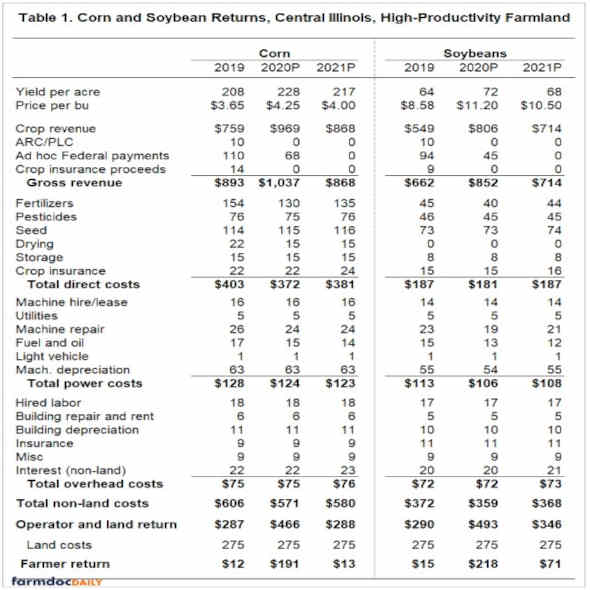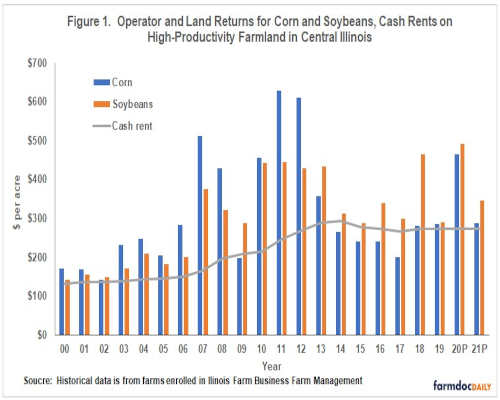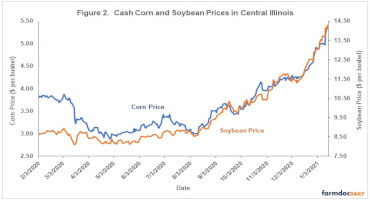By Gary Schnitkey and Krista Swanson et.al
Department of Agricultural and Consumer Economics
University of Illinois
By Carl Zulauf
Department of Agricultural, Environmental and Development Economics
Ohio State University
Publications on farmdoc giving 2020 and 2021 returns for Illinois grain crops have been revised since their last release in October 2020. Three changes have been made: 1) corn and soybean prices for 2020 and 2021 have been increased, 2) additional Federal-aid resulting from COVID-19 has been included, and 3) many non-land costs for 2021 have been increased. The 2021 Illinois Crop Budgets are available at this link. Historical costs are included in a farmdoc publication called Revenue and Costs for Illinois Grain Crops which is available from this link.
2020 Returns
Table 1 shows revenue and costs for crops grown in central Illinois on high-productivity farmland. Returns are shown for corn and soybeans for three years: 2019, 2020, and 2021. The 2019 values are summaries from farms enrolled in Illinois Farm Business Farm Management (FBFM). Historic returns back to 2014 for the central-high region — and for northern, central-low, and Southern Illinois regions — are available in the publication entitled Revenues and Costs for Illinois Grain Crops (link). Results for 2020 are projections as FBFM has not produced summaries for 2020. Similarly, 2021 values are projections.

For 2020, the projected corn yield is 228 bushels per acre, the corn price is $4.25 per bushel, resulting in $969 per acre in crop revenue. This $4.25 corn price is $.25 per bushel higher than the price used in the October 2020 Revenue and Costs for Illinois Grain Crops publication. The higher price reflects the large increases in corn prices that have been occurring in recent months. That price will vary across farms depending on the timing of marketing. Corn revenue also includes $68 of other ad hoc Federal payments related to the Coronavirus Food Assistance Program (CFAP). The $68 includes payments for:
- The second round of CFAP, which were $.23 per bushel times the actual production History yield (210 bushels per acre) in Figure 1.
- The third round of CFAP of $20 per acre authorized in December’s Consolidation Appropriation Act. These payments have not been received but are authorized.

The first round of CFAP was paid on 2019 production and is included in the $110 per acre of ad hoc Federal payments in 2019.
Total revenue for corn is projected at $1,037 per acre. Subtracting off $571 of non-land cost gives $466 of operator and land return. Operator and land return provides payments both to the farmer and landowner. Table 1 includes land costs of $275 per acre, representing the average cash rent for high-productivity farmland in central Illinois. Given this average cash rent, the farmer return is $191 per acre.
For 2020, the projected soybean yield is 72 bushels per acre, the soybean price is $11.20 per bushel, giving crop revenue of $806 per acre. The $11.20 price is $1.25 higher than the price used in the October 2020 Revenue and Costs for Illinois Grain Crops publication. There are $45 per acre in CFAP payments related to two rounds:
- The second round of CFAP, which were $.40 per bushel times the actual production History yield (63 bushels per acre) in Table 1.
- The third round of CFAP of $20 per acre authorized in December’s Consolidation Appropriation ace. These payments have not been received but are authorized.
Total revenue is $852 per acre. Given $369 in non-land costs and $275 in cash rent, farmer returns for soybeans are projected at $218 per acre.
2021 Returns
For 2021 projections, a corn price of $4.00 per bushel and a soybean price of $10.50 per bushel are used. These prices are substantially higher than in October budgets ($3.55 for corn and $9.45 for soybeans). These higher prices are close to bids for fall delivery of grain. Yields are at trend levels: 217 bushels per acre for corn and 68 bushels per acre for soybeans. Revenues are not included for ARC/PLC payments or Ad hoc Federal programs.
Fertilizer costs have been increased, as fertilizer prices have increased in recent months. For example, anhydrous ammonia prices now are near $500 per ton after being in the $415 per ton range in the fall of 2020.
Historical Perspectives
Figure 1 shows the projected 2020 and 2021 compared to historical returns. The 2020 operator and land return for corn is projected at $466 per acre. The last time corn returns exceeded $466 per acre was in 2021, when returns were $630 per acre. From 2013 to 2019, corn returns averaged $253 per acre, well below the 2019 projected return. The 2019 projected return is $89 per acre above the average 2013-2019 average return.
The 2020 operator and land return for soybeans is projected is $493 per acre, the highest return in history in central Illinois (see Figure 1). The average soybean return from 2013 to 2019 is $333 per acre, well below the 2021 projected return.
The operator and land return for corn in 2021 is projected at $288 per acre. This 2021 projected in $35 above the 2013-2019 average of $253 per acre. The soybean return is projected at $346 per acre, $35 higher than the 2013-2019 average of $333 per acre.
Price Changes
Much of the higher returns now being projected are due to price increases. Prices have increased dramatically since August 2020, as is illustrated by the cash prices for central Illinois shown in Figure 2. Corn prices increased from near $3.00 in August to over $5.00 in January. Soybean prices have increased from near $8.50 per bushel in August to $13.50 in January.

Based on these price increases and current levels of futures contracts on the Chicago Mercantile Exchange, projected levels of $4.00 per bushel for corn and $10.50 per bushel for soybeans are appropriate for 2021. Of course, large changes in 2021 prices can occur, as is illustrated by price swings in 2020. Lower prices likely would be associated with large crops in Brazil and the United States. Conversely, short crops could lead to higher prices. Demand factors obviously will have an impact on prices as well.
Summary
Price increases and continued announcements of ad hoc Federal payments have led to higher estimates of revenues and returns in 2020. Incomes in 2020 could be well above average for many farms in Illinois. The above returns do not include proceeds from the Paycheck Protection Program (PPP) and the Economic Injury Disaster Loans (EDIL), programs administered by the Small Business Administration (SBA) program. For participating farmers, those programs will add to cash flow.
There also appears to be a reason for optimism for 2021 returns. Of course, much can change between now and harvest in 2021.
Source : illinois.edu